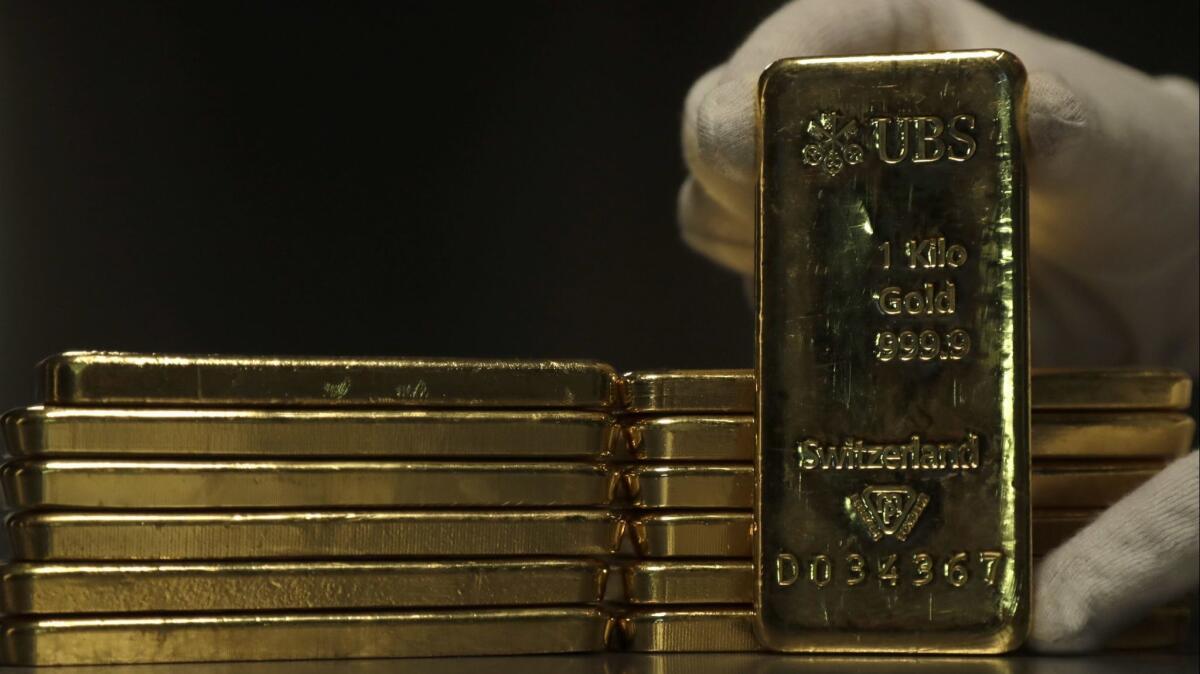In this mess of a market, havens like gold and U.S. bonds are making a comeback

- Share via
The remarkable thing about recent yen performance may not be the almost 4% surge against the dollar on Thursday but the fact the currency just clocked its best month in about two years.
That statistic also applies to gold, whose spot price jumped 5% in December, the largest gain since January 2017. Both assets have continued to climb this year; as of Thursday, gold was trading at $1,294.80 an ounce. Meanwhile, bonds of G-7 governments had their best December in a decade, according to a Bank of America Merrill Lynch index.
Put simply, traditional havens are back.
The same myriad drivers bedeviling equity investors in 2019 are sending them to safety. While the trade war is showing up in real-world data, it’s cropping up in company earnings too, as evidenced by Apple Inc.’s guidance cut on Wednesday. At the same time, Federal Reserve tightening is sapping liquidity and in the process reigniting volatility in markets. Idiosyncratic risks from the likes of Brexit and Italy’s budget squabble with the European Union are merely compounding the mood — and adding fuel to the haven trade.
“There are so many worries to investors at the moment — global economic slowdown, China, U.S. shutdown, Brexit, political risk,” Charles St-Arnaud, an investment strategist at Lombard Odier Asset Management in London, said by email. “On top of that, performance has been weak and volatility has increased for most asset classes. So it is understandable that some investors are going to safer havens to wait for some clarity.”
Apple’s gloomy update, which it blamed on weaker China demand, was cited by some as a factor in the yen’s wild jump during the Asian morning. The currency appears to have more upside potential — it’s among the most undervalued in the G-10 against the dollar, based on the Organization for Economic Cooperation and Development’s purchasing power parity measure. That’s a contrast with 2011, when the yen was overvalued by about 30% according to the same gauge.
Sentiment toward gold also brightened in mid-October, when money managers abandoned their record net-short position against the metal as the outlook for the dollar deteriorated. Since then, investors have piled into exchange-traded funds backed by bullion, which have amassed 126 tons of metal worth $5.2 billion in 60 sessions — the biggest increase over a comparable period in more than 18 months.
A paring of expectations for rate hikes has also contributed to demand, as gold typically falls during periods of monetary tightening because it’s a non-interest bearing asset.
Benchmark U.S. Treasury yields — which move in the opposite direction of prices — have dropped almost 70 basis points since early November as fears of slowing American growth are compounded by trade concerns and the partial government shutdown over President Trump’s border wall plans. The iShares 20-year Treasury exchange-traded fund, ticker TLT, saw a record one-day inflow on Wednesday. More than $1.1 billion poured into the fund, which invests in longer-dated U.S. government bonds.
“Safe havens should continue to outperform this year as a slowdown in the U.S. prompts the Fed to end its tightening cycle in the middle of the year and China’s economy continues to lose momentum,” Simona Gambarini, an economist at Capital Economics in London, said by email.
More to Read
Inside the business of entertainment
The Wide Shot brings you news, analysis and insights on everything from streaming wars to production — and what it all means for the future.
You may occasionally receive promotional content from the Los Angeles Times.










